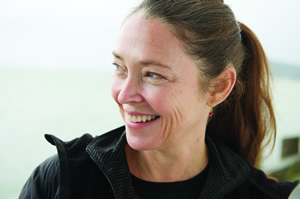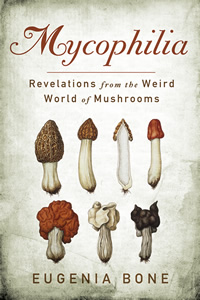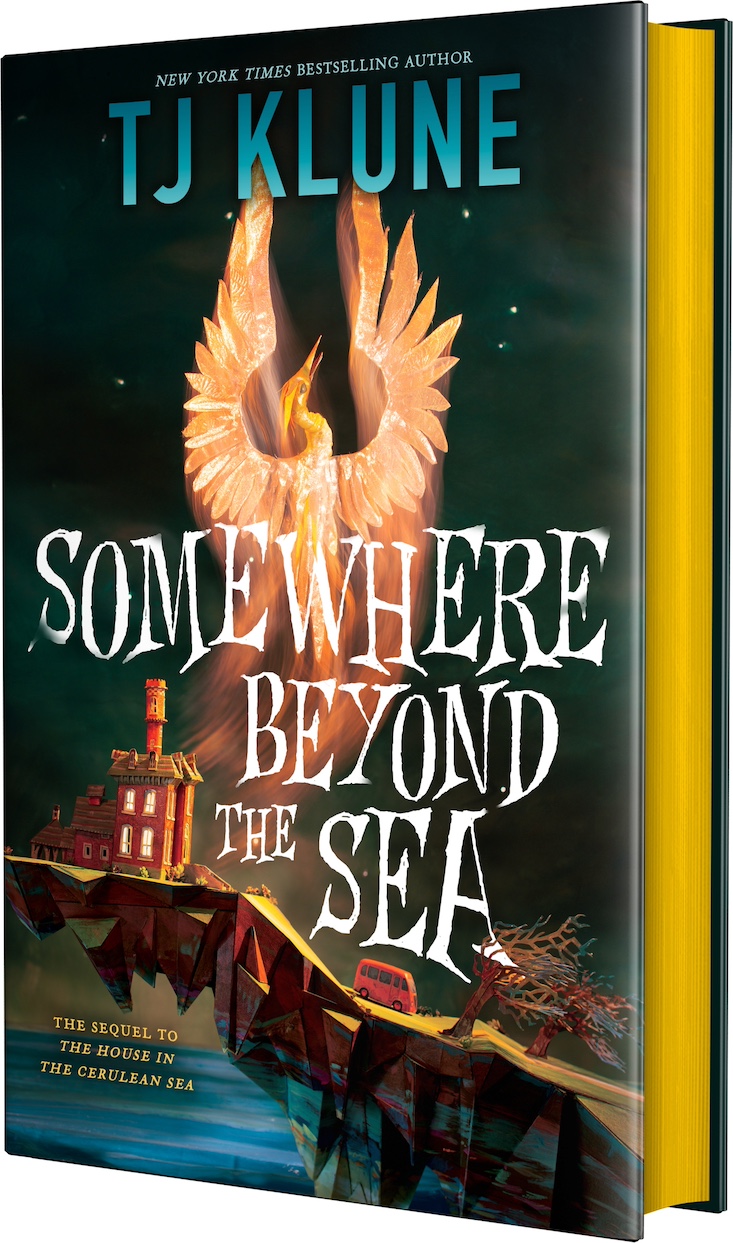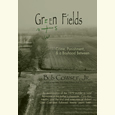Ecstasy in the Knowing
Mycophilia, Eugenia Bone’s exploration of the funky world of fungi, reveals the beauty and interconnectedness of all life
Eugenia Bone’s Mycophilia is the perfect “did-you-know” book. For instance, did you know that the largest single living organism on the planet is a fungus? Located in the Blue Mountains of eastern Oregon, this particular specimen of the wood-decaying fungus Armillaria gallicais the size of 1,666 football fields and is more than two thousand years old. It’s been nicknamed “the humongous fungus.” Bone’s delightful book is full of such fascinating facts, as well as vivid portraits of the unique mycophiles (or “fungus-lovers”) who inhabit the tremendously diverse and often surprising world of mushrooms and their fungal relatives. Bone is not a professional mycologist; she’s an enthusiastic amateur whose interest in the subject comes from a much more personal place. “My journey into the realm of fungi started with basic venality,” she writes. “I love to eat wild mushrooms, but I don’t love paying for them.”
In her quest for gastronomic satisfaction, Bone turns first to her local Mycological Society and signs up for its popular “Morel Breakfast,” in which dozens of mushroom hobbyists descend upon an abandoned apple orchard in upstate New York early on a May morning to search for the “free, fresh, and fat” morels among the tree roots. Although her efforts on that day prove “fruitless,” she slowly begins to appreciate the science behind the search as she learns that mushrooms are not plants but rather “the fruiting body of fungi, just as apples are the fruiting body of apple trees.” The fungus itself consists of “a network of branching tubelike structures one cell thick that traces a vast pattern underground, like a living spiderweb.” Fungi absorb the nutrients they need to live by secreting enzymes that break down surrounding organic matter. Once their current environment is depleted of nutrients, they grow and expand to reach the next food source.
 This behavior can be beneficial, neutral, or devastating to the host organism, depending on the type of fungus. Mycorrhizal fungi, for instance, live among the root systems of ninety percent of all plants, extracting nutrients from the soil that the plants need and exchanging them for sugars which the plants produce via photosynthesis. (Win, win.) Parasitic fungi, on the other hand, are predators that feed on and often destroy a variety of organisms, from plants to animals to—well, us. Finally there are the saprophytes, which feed on dead or dying hosts. These are the mushrooms most commonly available because they are the most easily cultivated; they include button, crimini, portobello, oyster, shiitake, and enoki. The rare and exotic morels, chanterelles, porcini, truffles, and matsutake are more commonly collected in the wild.
This behavior can be beneficial, neutral, or devastating to the host organism, depending on the type of fungus. Mycorrhizal fungi, for instance, live among the root systems of ninety percent of all plants, extracting nutrients from the soil that the plants need and exchanging them for sugars which the plants produce via photosynthesis. (Win, win.) Parasitic fungi, on the other hand, are predators that feed on and often destroy a variety of organisms, from plants to animals to—well, us. Finally there are the saprophytes, which feed on dead or dying hosts. These are the mushrooms most commonly available because they are the most easily cultivated; they include button, crimini, portobello, oyster, shiitake, and enoki. The rare and exotic morels, chanterelles, porcini, truffles, and matsutake are more commonly collected in the wild.
Bone’s mushroom adventures soon take her far and wide to mycological conferences, forest forays, and fungal festivals in Colorado, Massachusetts, Montana, California, Illinois, Oregon, Pennsylvania, and British Columbia. Along the way she meets a wide array of mycophiles, whom she characterizes as Masters of the Forest, World’s Leading Experts, Off the Gridders, Belly Feeders (she includes herself in this designation), and just plain Loonies. The latter admonish her to stroll casually when hunting morels so as not to “alert” the mushrooms, never say “the M word” while in the woods, and “never pick the first morel you see, because they send a signal underground to the other morels and then they’ll all go into hiding.” Of course, when the experts like to give their lectures titles like “Spores Illustrated” and dress up like Charles Darwin to discuss fungal evolution, it’s no surprise that they attract their fair share of eccentrics.
 As Bone learns more about the biology of mushrooms, her interest grows beyond her appetite. Given that “fungi outnumber plants by a ratio of six to one and make up twenty-five percent of the Earth’s biomass,” she soon realizes that fungi are ubiquitous in nature. “We inhale one to ten [fungal] spores with every breath,” she writes. “They live on every surface, in every organism to some degree or another, and some can theoretically live forever.” The wild mushroom hunter’s most crucial learning curve, however, has to be the identification of those extremely unfriendly varieties, which conveniently tend to have common names like “death cap” and “destroying angel.” Of the 1.5 million fungal species in existence, only about four hundred are believed to be poisonous: you are more likely to be eaten by a shark than poisoned by a mushroom. Nevertheless, the amateur must use extreme caution. Even among the experts, Bone relates, “there are old mushroom eaters and bold mushroom eaters, but no old, bold mushroom eaters.”
As Bone learns more about the biology of mushrooms, her interest grows beyond her appetite. Given that “fungi outnumber plants by a ratio of six to one and make up twenty-five percent of the Earth’s biomass,” she soon realizes that fungi are ubiquitous in nature. “We inhale one to ten [fungal] spores with every breath,” she writes. “They live on every surface, in every organism to some degree or another, and some can theoretically live forever.” The wild mushroom hunter’s most crucial learning curve, however, has to be the identification of those extremely unfriendly varieties, which conveniently tend to have common names like “death cap” and “destroying angel.” Of the 1.5 million fungal species in existence, only about four hundred are believed to be poisonous: you are more likely to be eaten by a shark than poisoned by a mushroom. Nevertheless, the amateur must use extreme caution. Even among the experts, Bone relates, “there are old mushroom eaters and bold mushroom eaters, but no old, bold mushroom eaters.”
Rather than working against her, Bone’s inexperience—combined with a contagious eagerness to learn and a playful passion for all things fungal—draws readers along on her journey of discovery. “When I started to understand how fungi live,” she writes, “I began to appreciate that every single life, be it an insect or a mushroom or a tree, lives in a web of interdependencies with other creatures, and as a result, each was way more complex and much more beautiful than I had ever imagined.” She examines a variety of topics related to this most under-appreciated organism, including changing appetites for mushrooms, the history of efforts to gather and/or cultivate them, understanding their nutritional benefits as well as their use in folk medicine, the effects of psychedelic mushrooms (“the black sheep of the mycological world,” which Bone samples in the course of her research), and proposals to use fungi in the bioremediation of sites contaminated by carbon-based pollutants, as well as to create new biofuels and pesticides. And then there are the “did-you-knows.” For instance, did you know that mushrooms should never be eaten raw because their cell walls are made of almost indigestible chitin, the same substance found in crab shells and squid beaks?
Readers will enjoy the science but stay for the story of the author’s growing awareness of and appreciation for the world around her—and us. Bone explains, “Everything changed after I learned about fungal lifestyles and how key they are to the functions of nature. Now when I look at anything—the walls of my house, the food I eat, the trees and parks, the potted orchids in the grocery store—I realize I am also looking at fungi. I’m seeing more than meets the eye. And while I know it is not a matter of faith, but science that has accessed this world to me, I nonetheless feel a kind of ecstasy in the knowing.”
Eugenia Bone will discuss Mycophilia at The Booksellers at Laurelwood in Memphis on March 7 at 6 p.m. Click here for more details.


